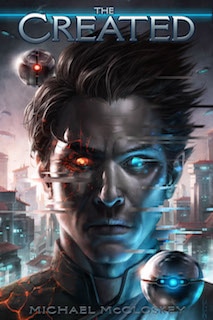August 2021 saw me reading many more books than I had anticipated. Some were re-reads, some were fiction and some were for information. One was all three.

The Created
McCloskey’s The Created is a fictional book that I re-read for information. Re-reading2 can be useful as it allows us to “read past the plot” since we’re no longer wanting to solely know “what’s next”. Re-reading allows us to dig deeper into the text, looking for more details and asking more layered questions than on the first pass.
On the surface, The Created is a short science fiction story about a rich and powerful guy who gets murdered, is resurrected and then seeks some revenge. But it’s also about AI, autonomous agents and bots, encryption, hacking, extraterrestrials, shared memories and reconstructing an identity and the personality that goes along with it.
Matthieu is dead, but his agents continue processing their duties and pursuing their previously assigned goals. These include an AI-enabled personal Assistant and a synthetic Hydrangea potted plant, also housing an AI. Both have access to their “Master’s” personal records including his bank accounts and some understanding of his life, both online and offline. And since at his death they didn’t receive instructions to stop seeking their goals, they continue, autonomously. Hydrangea uses its natural camouflage (who even takes a second glance at a potted plant?) to break into locations (usually under the Assistant’s instruction) and steal things—both physical and informational, passing them along to Assistant who has a wider view of the situation than does Hydrangea. Hydrangea sometimes hires carrier drones to get from place to place and will hack and suborn other bots to do its will, but also can move short distances by extending and then dragging itself along.3 Hydrangea also has some very impressive tools: optical and audio sensors, photosynthesis-capable biochemistry, wireless communication abilities and an assortment of gear to manipulate real-world things, too.
Another of Matthieu’s agents is Mimic, a flying bot that can reconfigure itself to fit into its environment or enable certain physical abilities like manipulating real-world objects. It also has significant autonomy (and curiosity) and flits about, eavesdropping, intercepting messages and tapping financial transactions. It, too, reports back to Assistant what it has found.
Orb is a fourth agent, a hovering eye-sized sphere with stealth capabilities whose primary goal is to witness and record certain events for Master to review privately. Since it also hasn’t been told to stop, it continues to pursue that goal.
Reading how McCloskey builds up this world raises several interesting questions:
- How do you program curiosity? Each of Master’s agents have a curious nature—they want to know things and so tug on the strings they find, leading them to interesting information that furthers the agents’ knowledge and the writer’s plot.
- Should our online agents stop after our death? Like in Suarez’ Daemon, there are repercussions that continue after our physical will has ceased. Are there legal questions to ask? If an agent is able to generate its own income and has its own online accounts, what would stop it from functioning after its “owner” (creator?) has died?
- Where do these agents run their AI: locally or accessed remotely? Where do they get all the power needed for their movement, surveillance, curiosity and autonomy?
- What if the “Metaverse” isn’t only about exploring and interacting with others in an online world through our avatars, but is also a way to send a simulacra into the real world while staying home? We’re already exploring museums this way with bots that we control remotely, from wherever we find ourselves.
Science fiction can be a mirror for exploring things that were, things that are and “some things that have not yet come to pass”. We would do well to think on them before we have to face them in more real situations.
More from Leyte Gulf
Hornfischer’s The last stand of the tin can sailors helped me understand Leyte Gulf more than Sears’ The Last Epic Naval Battle, although both are useful and have their place. James Hornfischer passed away earlier this year on June 2, 2021.
Huxley
I think Huxley’s Brave New World deserves its own post someday. Is it a cautionary tale, a handbook or just a good story?
To Kill a Mockingbird
Lee’s book is still useful as a lens into race, class and gender.
Rise and triumph
I continued Trueman’s Rise and triumph of the modern self but have not yet finished it—too dense to chew much more than a mouthful at any one sitting. I say this in praise of the book, not in its detraction.
Referenced:
Austen, J. (2020). Sense and sensibility. Mint Editions.
Dreher, R. (2018). The Benedict option. Sentinel, an imprint of Penguin Random House LLC.
Hornfischer, J. D. (2005). The last stand of the tin can sailors. Bantam Books.
Huxley, A. (2009). Brave New World. Penguin.
Lee, H. (2006). To kill a mockingbird. New York: Harper Perennial Modern Classics.
McCloskey, M. (2015). The Created. Squidlord LLC.
McCloskey, M. (2021). The Kriseel Invitation (Vol. 17, Ser. PIT). Squidlord LLC.
McCloskey, M. (2021). The Kriseel Ruins (Vol. 16, Ser. PIT). Squidlord LLC.
Weir, A. (2021). Project Hail Mary. Ballantine Books.4
Whitehead, C. (2012). Zone one: A novel. London.
- Cover art by Raymond Swanland. ↩
- See Sara McKenzie’s episode 141 for more on the benefits of re-reading. ↩
- Think of the Addams Family “Thing”. ↩
- This book arrived on my doorstep earlier in the year from Amazon, as a gift, signed “A Weir”. This is odd, since I’ve left reviews of his other two books (The Martian and Artemis) rating the books as excellent but Weir as a lazy writer who falls back on profanity too quickly. In PHM, he backs away from dropping F-bombs without need and shows some significant maturation in his writing ability. This is almost certainly his best book yet. ↩

